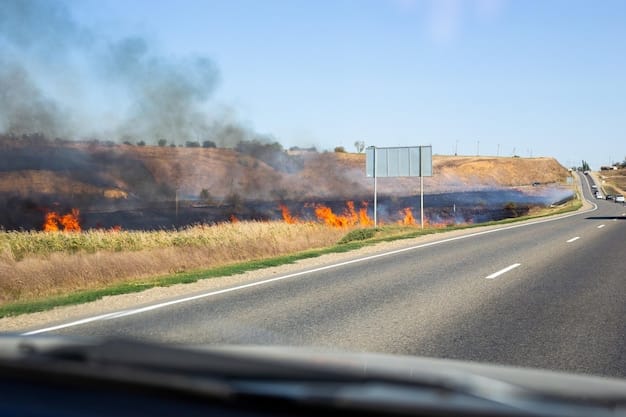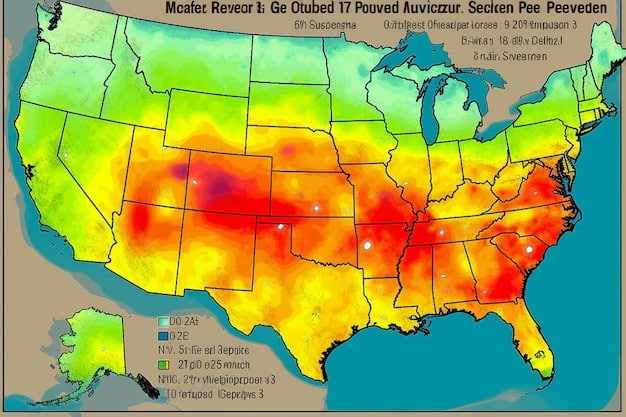US Infrastructure 2025: Extreme Heat’s Impact

The projected 15% increase in extreme heat days by 2025 is poised to significantly challenge US infrastructure, leading to potential disruptions in transportation, energy grids, and public health systems without substantial preparatory measures.
As climate patterns continue to evolve, understanding projections like How Will the Projected 15% Increase in Extreme Heat Days Impact US Infrastructure by 2025? becomes not just an academic exercise but a critical assessment for national resilience. This article delves into the anticipated challenges and potential solutions as the United States prepares for what could be a significantly warmer near future.
The Looming Challenge of Extreme Heat
The United States is projected to experience a 15% increase in extreme heat days by 2025, a statistic that underscores a growing climate reality. This isn’t merely about hotter summers; it’s about a fundamental shift in weather patterns that will inevitably stress the nation’s critical infrastructure. From urban centers to rural networks, the ramifications of prolonged high temperatures are extensive, affecting everything from energy consumption to structural integrity.
Historically, infrastructure has been designed with certain climatic parameters in mind. However, these parameters are rapidly being surpassed, demanding a rapid re-evaluation of current standards and proactive adaptation strategies. The challenge lies not only in anticipating the direct impacts of heat but also in understanding the cascading failures that can arise when interconnected systems buckle under stress.
Defining Extreme Heat Days
Extreme heat days are typically defined by temperatures that significantly exceed the average historical norm for a given region, often accompanied by high humidity. These conditions pose direct threats to human health and place immense strain on both natural and built environments. The increase signifies more frequent and intense heatwaves, extending their reach into areas previously less affected.
- 🌡️ Temperature Thresholds: Often set at the top 10% of historical temperatures for a specific date or period.
- ⏳ Duration: Refers to consecutive days of extreme heat, which amplify impacts.
- 💧 Humidity: High humidity exacerbates the feeling of heat and reduces the body’s ability to cool itself.
The scientific consensus highlights that while daily averages are rising, the increase in extreme events is particularly concerning. These events are where the most significant infrastructure vulnerabilities often become apparent. Understanding the nuances of these definitions is crucial for developing targeted mitigation and adaptation plans.
The escalating frequency of extreme heat days is a clear indicator of climate change at play. This increase is largely driven by anthropogenic greenhouse gas emissions, which trap heat in the atmosphere. The implications stretch far beyond just discomfort, affecting economic productivity, public health, and the very stability of our foundational systems. Preparing for this future requires an integrated approach, recognizing that the challenge is systemic rather than localized.
Impact on Energy and Power Grids
A 15% increase in extreme heat days by 2025 will exert immense pressure on the US energy and power grids. As temperatures soar, the demand for air conditioning and refrigeration skyrockets, pushing electricity grids to their limits. This surge in demand, coupled with the reduced efficiency of power generation equipment in high heat, creates a precarious balance that can lead to blackouts and brownouts.
Thermal power plants, a significant component of the US energy mix, rely on cooling water to operate efficiently. Elevated ambient and water temperatures can reduce their output. Transmission lines also suffer; high heat causes lines to sag and lose capacity due to increased electrical resistance, increasing the risk of power outages. The combined effect of increased demand and diminished supply capacity presents a significant risk to grid stability.
Grid Vulnerabilities and Resilience
The current US power grid is an aging system, with many components designed for cooler climates. Transformers, substations, and distribution lines are all susceptible to overheating, leading to equipment failure. The projected increase in extreme heat days means these vulnerabilities will be tested more frequently and intensely. Developing a resilient grid means investing in modernizing infrastructure, incorporating smart grid technologies, and diversifying energy sources.
- 🔥 Overheating Components: Transformers and substations are prone to failure under prolonged high temperatures.
- ⚡ Power Outages: Increased demand combined with reduced supply capacity leads to service disruptions.
- 💡 Renewable Integration: Solar power output can decrease slightly with extreme heat, while wind power can be less predictable.
Beyond the technical challenges, the socioeconomic consequences of grid failures during heatwaves are severe. Vulnerable populations, lacking access to cooling centers or backup power, face significant health risks. Businesses suffer financial losses due to disrupted operations. Therefore, enhancing grid resilience is not just an engineering challenge but a public safety imperative.
Utilities and policymakers are increasingly recognizing the urgency of this issue. Strategies include hardening existing infrastructure, implementing demand-response programs to manage peak loads, and exploring advanced energy storage solutions. Microgrids and distributed energy resources also offer promising pathways to reduce reliance on vulnerable centralized grids, providing localized power during widespread outages caused by extreme heat events.
Transportation Systems Under Pressure
The nation’s transportation network—roads, bridges, railways, and airports—is another critical area facing significant stress from increased extreme heat days. Materials used in construction, such as asphalt and concrete, behave differently under prolonged high temperatures. This can lead to rapid deterioration, increased maintenance costs, and potential safety hazards. The efficiency and reliability of transportation services are directly threatened, impacting supply chains and daily commutes.
Asphalt roads can soften and develop ruts under heavy traffic and extreme heat. Concrete structures, including bridges, can experience thermal expansion and contraction, leading to cracks and structural fatigue over time. Railways are prone to “sun kinks,” where tracks buckle due to thermal expansion, causing train delays and increasing the risk of derailments. These issues collectively pose a significant challenge to the continuity and safety of the transportation sector.
Adapting Roadways and Railways
Adapting transportation infrastructure to extreme heat requires innovative engineering and proactive maintenance. For roadways, this involves using heat-resistant materials and developing improved construction techniques that account for higher temperature tolerances. Railways may need regular monitoring for track buckles and the implementation of stress-relief measures. For both, proper drainage is critical, as extreme heat often exacerbates the impacts of accompanying heavy rainfall events.
- 🛣️ Roadway Degradation: Asphalt softening, rutting, and increased wear and tear.
- 🚄 Rail Track Buckling: Thermal expansion leading to “sun kinks” and derailment risks.
- ✈️ Airport Operations: Heat can affect aircraft lift, potentially requiring reduced payloads.
The implications extend beyond physical damage. Public transportation systems, including buses and subways, may face increased service disruptions. Airports can experience delays as extreme heat impacts aircraft performance, potentially requiring longer runways for takeoff or reduced payload capacity. This ripple effect can disrupt not just local travel but also national and international logistics and commerce.
Investment in research and development for climate-resilient transportation materials and designs is paramount. Furthermore, integrating climate data into infrastructure planning cycles will enable better forecasting of stress points and more strategic allocation of resources for maintenance and upgrades. Proactive measures now will mitigate far greater costs and disruptions in the future, ensuring the robustness of the US transportation backbone.

Water Resources and Public Health Infrastructure
The impending 15% rise in extreme heat days by 2025 presents a multifaceted threat to water resources and public health infrastructure across the US. Higher temperatures accelerate evaporation from reservoirs and rivers, reducing water availability, particularly in already arid regions. This diminished supply can strain municipal water systems that serve growing populations, potentially leading to water restrictions and conflicts over resource allocation.
Beyond quantity, water quality is also a concern. Warmer water can promote the growth of harmful algae blooms in lakes and reservoirs, contaminating drinking water sources and posing risks to aquatic ecosystems. Furthermore, the infrastructure used to treat and distribute water—pumping stations, pipes, and treatment plants—can be adversely affected by heat-related power outages, compromising the delivery of safe drinking water.
Health System Preparedness
On the public health front, extreme heat is a direct threat, leading to heat strokes, dehydration, and exacerbating cardiovascular and respiratory conditions. The elderly, young children, and individuals with pre-existing health conditions are particularly vulnerable. Healthcare facilities, including hospitals and emergency services, face increased demand for services during heatwaves, potentially overwhelming existing capacities if not adequately prepared.
- 🚑 Increased Heat-Related Illnesses: Higher rates of heat stroke, dehydration, and exacerbated chronic conditions.
- 🌡️ Strain on Healthcare: Emergency rooms overloaded, increased demand for ambulance services.
- 🌬️ Cooling Centers: Need for designated, accessible cooling centers for vulnerable populations.
Maintaining air conditioning in public buildings and private residences becomes essential, putting further strain on the energy grid. Local public health agencies must develop robust heat action plans that include public awareness campaigns, the establishment of cooling centers, and protocols for identifying and assisting vulnerable populations. The integrity of wastewater treatment facilities can also be compromised by extreme heat, impacting sanitation and environmental health.
Investing in water conservation technologies, improving water infrastructure to reduce leaks, and developing climate-resilient water management strategies are crucial. For public health, this means not only preparing for acute heat-related emergencies but also building long-term resilience through community engagement, improved urban planning (e.g., increased green spaces), and enhanced healthcare system capacity. The interconnectedness of water and health infrastructure necessitates a holistic and coordinated response to the impacts of extreme heat.
Digital and Communication Infrastructure
In our increasingly interconnected world, the reliance on digital and communication infrastructure is absolute. A 15% increase in extreme heat days by 2025 poses a significant threat to these vital systems. Data centers, which house critical servers and networking equipment, require constant cooling to operate efficiently. Elevated ambient temperatures raise the energy demand for cooling, increasing operational costs and the risk of server overheating and failure if cooling systems are compromised or insufficient.
Telecommunication networks, including cell towers and fiber optic cables, are also vulnerable. Electronic components within cell towers can malfunction or degrade faster under sustained high temperatures. Fiber optic cables, while less susceptible to direct heat damage, can be affected by ground shifts or expansion in conduits exacerbated by temperature extremes. The cascading effect of failures in these systems can disrupt essential services, from emergency communications to financial transactions.
Protecting Data Centers and Networks
Protecting digital and communication infrastructure from extreme heat involves a multi-pronged approach focused on redundancy, efficient cooling, and strategic placement. For data centers, this means investing in more robust and energy-efficient cooling technologies, implementing advanced monitoring systems to detect overheating, and exploring alternative cooling methods. Ensuring resilient power supplies, including backup generators and uninterruptible power sources, is paramount to maintain operations during grid disruptions.
- 🖥️ Data Center Overheating: Increased energy consumption for cooling; risk of server failure.
- 📡 Telecommunication Disruptions: Malfunctioning components in cell towers; cable integrity issues.
- 🚨 Emergency Services Impact: Compromised communication channels for first responders.
For telecommunication networks, hardening infrastructure against environmental stressors is key. This could include using heat-resistant materials for enclosures and equipment, improving ventilation in outdoor installations, and planning for redundant network paths to reroute traffic if a component fails. Given the distributed nature of these networks, localized impacts can rapidly escalate into widespread disruptions.
The economic implications of digital infrastructure failure are immense, leading to losses in productivity, revenue, and public confidence. From a societal perspective, the ability to communicate, access information, and conduct daily activities becomes severely hampered. Therefore, proactive investment in resilient digital infrastructure is not just a commercial necessity but a cornerstone of national security and economic stability in a hotter climate.
Economic and Societal Repercussions
The projected 15% increase in extreme heat days by 2025 carries substantial economic and societal repercussions for the US. Beyond the direct costs of infrastructure damage and repairs, there are significant indirect costs related to lost productivity, increased healthcare expenditures, and decreased agricultural output. These factors can collectively hinder economic growth and exacerbate existing social inequalities.
Productivity losses are a major concern. Outdoor workers, particularly in construction, agriculture, and emergency services, face increased health risks and often reduced work hours during heatwaves. Indoor workers may also experience discomfort and reduced efficiency if cooling systems are inadequate. This slowdown in economic activity can be particularly impactful in sectors heavily reliant on physical labor.
Vulnerable Populations and Equity
Societally, extreme heat disproportionately affects vulnerable populations, including low-income communities, the elderly, and those with chronic health conditions, who may lack access to air conditioning, cooling centers, or adequate healthcare. This exacerbates health disparities and can lead to increased mortality rates among these groups. The strain on public services, particularly emergency response and healthcare, adds to the societal burden.
- 📉 Productivity Loss: Reduced output in labor-intensive sectors due to heat-related illnesses and reduced work hours.
- 💰 Economic Disruption: Supply chain interruptions, increased energy costs for businesses and households.
- ⚖️ Social Inequality: Disproportionate impact on vulnerable populations lacking access to cooling and healthcare.
Furthermore, agricultural production can suffer significantly. Extreme heat can stress crops, reduce yields, and impact livestock health, leading to higher food prices and potential food insecurity. The cumulative effect of these economic and societal disruptions can diminish national resilience and create new challenges for governance and community well-being.
Addressing these repercussions requires a comprehensive approach that includes targeted investments in resilient infrastructure, the development of robust public health warning systems, and policies that support vulnerable communities. Embracing sustainable urban planning, such as increasing tree canopy and promoting green infrastructure, can help mitigate urban heat island effects. Ultimately, recognizing the broad and interconnected impacts of extreme heat is the first step toward building a more resilient and equitable nation.

Strategies for Adaptation and Mitigation
Facing a projected 15% increase in extreme heat days by 2025, the US needs robust strategies for adaptation and mitigation. Adaptation focuses on reducing the negative impacts of heat that are already inevitable, while mitigation aims to reduce the greenhouse gas emissions causing the warming. A comprehensive approach integrates both, anticipating future challenges while working to alleviate their root causes.
One key strategy is modernizing and hardening existing infrastructure. This involves not only repairing and replacing aging components but also designing new infrastructure with future climate conditions in mind. For example, using heat-resistant materials in construction, improving cooling systems for critical facilities, and developing smart grid technologies to manage energy demand more efficiently.
Policy and Investment Innovations
At the policy level, integrated planning across different sectors—energy, transportation, water, and public health—is crucial. This means breaking down silos and fostering collaboration between federal, state, and local governments, as well as with the private sector. Policies can incentivize investments in renewable energy, energy efficiency, and climate-resilient development. Financial mechanisms, such as disaster preparedness funds and climate bonds, can help fund these necessary upgrades.
- 🏗️ Infrastructure Hardening: Upgrading roads, rails, and utility grids with heat-resistant materials.
- 💡 Energy Efficiency: Promoting energy-efficient buildings and appliances to reduce peak demand.
- 🌳 Green Infrastructure: Increasing urban tree cover and green spaces to combat heat island effects.
Furthermore, community-level initiatives are vital. This includes developing robust early warning systems for heatwaves, establishing publicly accessible cooling centers, and implementing public awareness campaigns about heat-related health risks. Urban planning can play a significant role by promoting green infrastructure like parks and tree-lined streets, which naturally cool urban environments and reduce the urban heat island effect.
Investing in research and development for climate-resilient technologies and practices is also paramount. This includes innovations in materials science, energy storage, and climate modeling. By combining proactive planning, strategic investment, and scientific advancement, the US can significantly enhance its resilience to extreme heat, safeguarding its infrastructure and the well-being of its population.
| Key Area | Brief Description of Impact |
|---|---|
| ⚡ Energy Grids | Increased demand, reduced efficiency, higher risk of outages. |
| 🚗 Transportation | Road softening, rail buckling, airport operational limits. |
| 💧 Water & Health | Water scarcity, quality issues, increased heat-related illnesses. |
| 📶 Digital & Comm. | Data center overheating, network component failure risks. |
Frequently Asked Questions
▼
It means that by 2025, the United States is projected to experience 15% more days with temperatures significantly above historical averages. These “extreme heat days” often contribute to heatwaves, putting greater stress on infrastructure and human health due to prolonged exposure to intense heat.
▼
Extreme heat increases electricity demand for cooling (e.g., air conditioning), potentially overwhelming the grid. It also reduces the efficiency of power plants and causes transmission lines to sag and lose capacity, escalating the risk of blackouts and equipment failures across the network.
▼
Roads can soften and crack, railways can buckle (sun kinks), leading to delays and safety issues. Extreme heat can also affect aircraft performance, potentially limiting payloads or causing airport delays, impacting both personal travel and commercial logistics.
▼
Higher temperatures accelerate water evaporation from reservoirs, leading to potential water scarcity. Warm water can also promote harmful algae growth. For public health, extreme heat increases heat-related illnesses and strains healthcare systems, especially for vulnerable populations.
▼
Mitigation strategies include modernizing infrastructure with heat-resistant materials, investing in renewable energy and energy efficiency, implementing smart grid technologies, and developing comprehensive heat action plans. Community-level initiatives like cooling centers and urban greening are also crucial.
Conclusion
The projected 15% increase in extreme heat days by 2025 represents a significant and imminent challenge to the foundational infrastructure of the United States. From the stability of our energy grids and the integrity of our transportation networks to the reliability of our water systems and the resilience of public health services, every sector faces heightened stress. This isn’t merely a matter of inconvenience but a critical issue of national security, economic stability, and public well-being. Proactive and integrated strategies, encompassing significant investment in climate-resilient infrastructure, innovative policy solutions, and community-level preparedness, are imperative to mitigate the adverse impacts and build a more adaptable nation for the warmer decades ahead.





